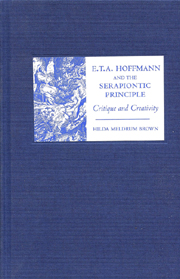Book contents
- Frontmatter
- Contents
- List of Illustrations
- Preface
- Acknowledgments
- List of Abbreviations
- Introduction: Approaches to the Serapiontic Principle
- Part 1
- 1 Overture: Jacques Callot
- 2 Der Einsiedler Serapion: The Formulation of a Principle
- 3 Der Dichter und der Komponist: Text and Music
- 4 Alte und neue Kirchenmusik
- 5 Prinzessin Brambilla: Callot Revisited
- 6 Epilogue: Des Vetters Eckfenster
- Part 2
- Conclusion
- Select Bibliography
- Index
5 - Prinzessin Brambilla: Callot Revisited
from Part 1
Published online by Cambridge University Press: 05 February 2013
- Frontmatter
- Contents
- List of Illustrations
- Preface
- Acknowledgments
- List of Abbreviations
- Introduction: Approaches to the Serapiontic Principle
- Part 1
- 1 Overture: Jacques Callot
- 2 Der Einsiedler Serapion: The Formulation of a Principle
- 3 Der Dichter und der Komponist: Text and Music
- 4 Alte und neue Kirchenmusik
- 5 Prinzessin Brambilla: Callot Revisited
- 6 Epilogue: Des Vetters Eckfenster
- Part 2
- Conclusion
- Select Bibliography
- Index
Summary
Even after having explored the extensive opportunities for analysing his aesthetic theories afforded by the framework in Die Serapionsbrüder, Hoffmann continues right to the very end of his career to examine points not covered there or to clarify and develop other key issues in greater detail than had been possible within the scope of the frame discussions. Prinzessin Brambilla offers the opportunity of tackling irony, a topic that had been somewhat neglected in the Serapionsbrüder (presumably, as I suggested above, because of the fictional frame itself) but that had been briefly identified as a key principle as early as the Callot preface to the Fantasiestücke. The tale also enlarges on the topic of allegory, which had only been summarily addressed so far. By a happy coincidence — the presentation to Hoffmann of eight original Callot prints of the Carnival by a friend — he had a suitable model on which to expand and develop in more theoretical terms what had become central features of his own narrative technique.
Prinzessin Brambilla is generally regarded as one of Hoffmann's most complex and difficult works and possibly for this reason has become a particular source of attraction to those who have praised its “unerschöpfliche Bildgestalt” and its “bewegliches Spiel der Konstruktion und Dekonstruktion.” This approach might be thought to cast doubt on any view of Prinzessin Brambilla that regards it a source of material to illustrate the further development of aspects of Hoffmann's aesthetic theory.
- Type
- Chapter
- Information
- E. T. A. Hoffmann and the Serapiontic PrincipleCritique and Creativity, pp. 92 - 105Publisher: Boydell & BrewerPrint publication year: 2006



